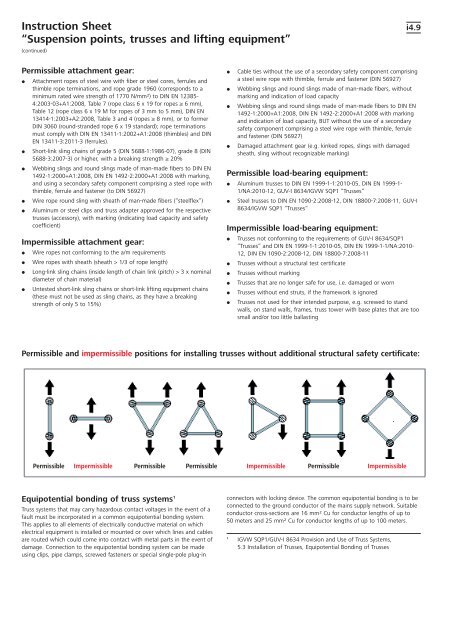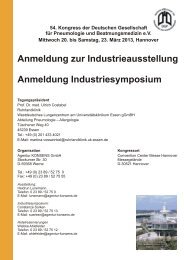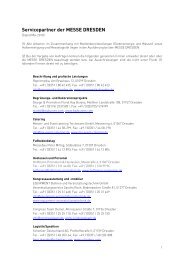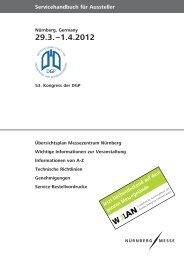Instruction Sheet - Agentur KONSENS
Instruction Sheet - Agentur KONSENS
Instruction Sheet - Agentur KONSENS
Create successful ePaper yourself
Turn your PDF publications into a flip-book with our unique Google optimized e-Paper software.
42<br />
<strong>Instruction</strong> <strong>Sheet</strong><br />
“Suspension points, trusses and lifting equipment”<br />
(continued)<br />
Permissible attachment gear:<br />
� Attachment ropes of steel wire with fiber or steel cores, ferrules and<br />
thimble rope terminations, and rope grade 1960 (corresponds to a<br />
minimum rated wire strength of 1770 N/mm²) to DIN EN 12385-<br />
4:2003-03+A1:2008, Table 7 (rope class 6 x 19 for ropes ≥ 6 mm),<br />
Table 12 (rope class 6 x 19 M for ropes of 3 mm to 5 mm), DIN EN<br />
13414-1:2003+A2:2008, Table 3 and 4 (ropes ≥ 8 mm), or to former<br />
DIN 3060 (round-stranded rope 6 x 19 standard); rope terminations<br />
must comply with DIN EN 13411-1:2002+A1:2008 (thimbles) and DIN<br />
EN 13411-3:2011-3 (ferrules).<br />
� Short-link sling chains of grade 5 (DIN 5688-1:1986-07), grade 8 (DIN<br />
5688-3:2007-3) or higher, with a breaking strength ≥ 20%<br />
� Webbing slings and round slings made of man-made fibers to DIN EN<br />
1492-1:2000+A1:2008, DIN EN 1492-2:2000+A1:2008 with marking,<br />
and using a secondary safety component comprising a steel rope with<br />
thimble, ferrule and fastener (to DIN 56927)<br />
� Wire rope round sling with sheath of man-made fibers (“steelflex”)<br />
� Aluminum or steel clips and truss adapter approved for the respective<br />
trusses (accessory), with marking (indicating load capacity and safety<br />
coefficient)<br />
Impermissible attachment gear:<br />
� Wire ropes not conforming to the a/m requirements<br />
� Wire ropes with sheath (sheath > 1/3 of rope length)<br />
� Long-link sling chains (inside length of chain link (pitch) > 3 x nominal<br />
diameter of chain material)<br />
� Untested short-link sling chains or short-link lifting equipment chains<br />
(these must not be used as sling chains, as they have a breaking<br />
strength of only 5 to 15%)<br />
� Cable ties without the use of a secondary safety component comprising<br />
a steel wire rope with thimble, ferrule and fastener (DIN 56927)<br />
� Webbing slings and round slings made of man-made fibers, without<br />
marking and indication of load capacity<br />
� Webbing slings and round slings made of man-made fibers to DIN EN<br />
1492-1:2000+A1:2008, DIN EN 1492-2:2000+A1:2008 with marking<br />
and indication of load capacity, BUT without the use of a secondary<br />
safety component comprising a steel wire rope with thimble, ferrule<br />
and fastener (DIN 56927)<br />
� Damaged attachment gear (e.g. kinked ropes, slings with damaged<br />
sheath, sling without recognizable marking)<br />
Permissible load-bearing equipment:<br />
� Aluminum trusses to DIN EN 1999-1-1:2010-05, DIN EN 1999-1-<br />
1/NA:2010-12, GUV-I 8634/IGVW SQP1 “Trusses“<br />
� Steel trusses to DIN EN 1090-2:2008-12, DIN 18800-7:2008-11, GUV-I<br />
8634/IGVW SQP1 “Trusses“<br />
Impermissible load-bearing equipment:<br />
� Trusses not conforming to the requirements of GUV-I 8634/SQP1<br />
“Trusses“ and DIN EN 1999-1-1:2010-05, DIN EN 1999-1-1/NA:2010-<br />
12, DIN EN 1090-2:2008-12, DIN 18800-7:2008-11<br />
� Trusses without a structural test certificate<br />
� Trusses without marking<br />
� Trusses that are no longer safe for use, i.e. damaged or worn<br />
� Trusses without end struts, if the framework is ignored<br />
� Trusses not used for their intended purpose, e.g. screwed to stand<br />
walls, on stand walls, frames, truss tower with base plates that are too<br />
small and/or too little ballasting<br />
Permissible and impermissible positions for installing trusses without additional structural safety certificate:<br />
Permissible Impermissible Permissible Permissible Impermissible Permissible<br />
Impermissible<br />
Equipotential bonding of truss systems 1<br />
Truss systems that may carry hazardous contact voltages in the event of a<br />
fault must be incorporated in a common equipotential bonding system.<br />
This applies to all elements of electrically conductive material on which<br />
electrical equipment is installed or mounted or over which lines and cables<br />
are routed which could come into contact with metal parts in the event of<br />
damage. Connection to the equipotential bonding system can be made<br />
using clips, pipe clamps, screwed fasteners or special single-pole plug-in<br />
i4.9<br />
connectors with locking device. The common equipotential bonding is to be<br />
connected to the ground conductor of the mains supply network. Suitable<br />
conductor cross-sections are 16 mm² Cu for conductor lengths of up to<br />
50 meters and 25 mm² Cu for conductor lengths of up to 100 meters.<br />
1 IGVW SQP1/GUV-I 8634 Provision and Use of Truss Systems,<br />
5.3 Installation of Trusses, Equipotential Bonding of Trusses






